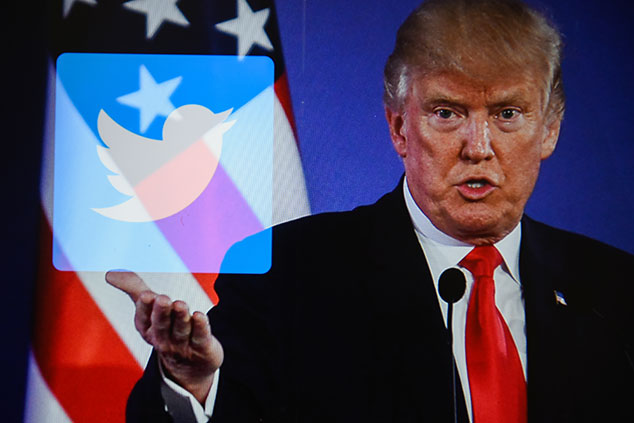
This article is taken from our FREE daily investment email Money Morning.
Every day, MoneyWeek’s executive editor John Stepek and guest contributors explain how current economic and political developments are affecting the markets and your wealth, and give you pointers on how you can profit.
The US president has a device on his person at all times.
With this device, he can unleash havoc upon the world, at the mere touch of a button.
I’m not talking about the nuclear football.
I’m talking about Donald Trump’s smartphone.
The US-China trade deal has suddenly taken a surprise turn
Markets had been banking on the US and China doing a trade deal in the near future. Expectations were not high about the quality of said deal, but most investors had been hoping it would at least kick concerns about trade into the longer grass for the moment.
And then Donald Trump decided to get on Twitter. On Sunday, he issued a screed which included the following (capital letters are all his): “The Trade Deal with China continues, but too slowly, as they attempt to renegotiate. No!”
As a result, on Friday, he said, he’s going to increase tariffs on $200bn-worth of goods from 10% to 25%. And – not on Friday, but “shortly” – he’s going to put tariffs of 25% on another $325bn of imports from China.
US negotiators added some clarity to Trump’s tweets yesterday. They said that China has reneged on “prior commitments” – reportedly over the protection of intellectual property – possibly because of pushback from politicians back in Beijing. They still want to talk – but the tariff hikes will go ahead in the meantime.
Is this a tactic? Of course it is. That’s a daft question. Negotiation is all tactics.
Is it the right tactic? That’s a better question. But the right tactic for who? The only person who really counts in this is Trump. So what’s he hoping to gain?
On the one hand, Trump wants his supporters (both within the Republican Party and through the wider country) to see that he’s being tough on China. In recent weeks, the idea has grown that the deal will be watered down and won’t really address the big issues. The stockmarket may not care about that, but Trump doesn’t want to be seen as a pushover with an election in 2020.
On the other hand, there’s the risk that “no deal” hammers the stockmarket and, in the medium term, starts to have a genuine effect on global trade (which has been in the doldrums anyway). No president wants to go into an election with the economy faltering. That’s when the incumbent tends to lose.
So what’s the “have my cake and eat it” outcome? Trump wants to get a deal, but also to make it look as though he’s been tough on China. He has time in hand to do that. So, yes, it makes sense that he’s done it.
But that doesn’t mean that there aren’t risks attached. And what’s interesting for us as investors is that markets in general don’t seem inclined to attend to those risks.
Markets are too willing to believe that everything will be fine
Markets initially fell hard on Trump’s tweets. But it’s also clear that investors are still in “buy the dip” mode. The Dow fell by about 450 points at the start of the day, but it then recovered to end the day just 0.3% lower.
Meanwhile, although Chinese markets dived much more significantly, they also revived somewhat on the news that the Chinese delegation will still travel to Washington for further talks later this week.
Remember that this is also coming after one of the strongest starts to a year on record. This is a market that is very much in “the glass is half full” mode. Investors are willing to believe that this is just a tactic on Trump’s part, and that a deal is still in the making.
They might be right. A lot of this stuff is about saving face – more than anything else, Trump wants to look tough, so if the Chinese can find a way to give him that while looking canny at their end, then a deal will get done pretty quickly. Indeed, I’d still put the odds on a deal getting done soonish as high enough to be the central scenario.
But, as I say, the interesting thing for us as investors is to observe that sentiment is firmly in “look on the bright side” mode, which means there’s more scope for disappointment. In other words, markets might be right to assume that a deal is the option with the highest odds. But they might be far too confident about that, and neglecting the “tail risk” of other outcomes.
And, as Capital Economics points out, if a deal doesn’t get done, those outcomes could have a pretty significant effect on markets.
If everyone’s fretting about Chinese growth – well, higher tariffs on Chinese exports will put a dent in that. And then there’s the risk to the Chinese currency – more weakness in the yuan could trigger more tension between the two countries, not to mention the destabilising impact of a serious devaluation in the yuan.
What’s my point? Proceed with caution. Stick to your plan and have a watchlist (for buying stuff cheap when a correction comes). Exuberant markets will keep making progress through bad news, but when they finally tip, they fall hard.
Oh, and for more on how the trade dispute between China and the US might affect businesses who are trying to plan ahead in this volatile political environment, have a read at this article (written in association with our partners at currency specialists OFX) – Beware: the trade war between China and the US could just be the beginning.